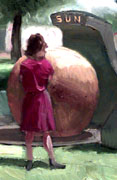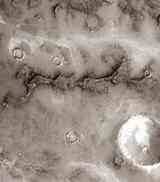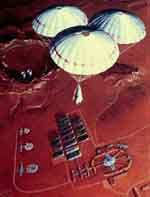Summary of Contributor Responses |
||||
|
On this overall perspectives page are summarized the most frequently
occurring responses to the three questions. These common threads are
discussed first (the numbered summaries) without regard to the field
from which they came and, immediately following, contrasted between
the two broad categories of "the arts" and "the sciences".
But people are complex, and no summary can be as meaningful as reading
fully what each of these unique and creative people have to say. An
overview here has only been attempted by your host in the hope that
what is discovered might be helpful to students, as well as to parents
and teachers in their quest to guide and nurture young people to become
the best that they can be.
Once one starts down this path of attempting to identify and interpret conditions that may be conducive to finding a life of involvement and interest, which often leads to the pursuit of excellence, there is a temptation to cover all the bases. But a website is not the place for a thesis, and so you will find here only the tip of the iceberg. It was important, however, to read Prof. Mihaly Csikszentmihalyi's first–class book entitled Creativity, which explores the lives of 91 creative people in greater depth than done here with the three basic questions asked of the Mars Millennium Project (MMP) respondents. The result of this comparison clearly identified many similar traits across the full range of the Creativity and the MMP respondents. In terms of what factors most influenced the many different MMP contributors in choosing their particular fields in the first place, the most frequently occurring explanations, in decreasing order (with percentages in parentheses), are shown below. Naturally, one must always be mindful that the MMP sample size was not large (72), as well as the fact that many of those choosing to participate may have already had a "dream–of–space" bias. Nonetheless, the findings seem of significant value to those seeking to find an exciting, "alive", and rewarding life. There was also evidence that "the younger, the better" held generally true for when exposure to a given factor carried the greatest leverage. |
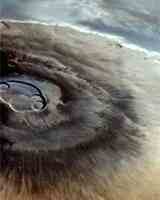 |
|||
Major Features of the Creative Process: |
||||
|
Turning next to the second question, there was a total of 211 cited
reasons from the 72 contributors in the various categories listed
below. The most frequently occurring reasons were:
1. 19% – The importance of a strong educational background and being prepared and knowledgeable before undertaking the activity. This could manifest as a solid grounding in math and physics for a scientist or engineer, or as a good grasp of technique for an artist such as a painter, photographer, sculptor, dancer, etc. In Creativity, it was wonderful to learn that almost all respondents pursued the quest for knowledge until the end of life, remaining "eager for the chase". 2. 18% – The ability to conceptualize the task at hand and engage in broad and deep thought about it before getting on with the detailed process of solving the problem or carrying out the activity. Many expressed the importance of getting at the "big picture" first before jumping into the rest of the solution process. In Creativity, Csikszentmihalyi notes the added importance of having clear goals and a good match of the creative person's capability with the challenge he or she faces. 3. 9% – The importance of relaxing a bit after a period of intense thought and work. This seems to allow the creative process to continue working in a less constrained, more free–form manner, often leading to the "aha" solution that springs forth when it is ready to emerge. This can happen when first awaking in the morning, or when taking a stroll down a scenic path. This was frequently expressed by the Creativity respondents as well, as part of the process of learning the field, incubating an idea, relaxing a bit to experience the "aha", evaluating the solution, and finally implementing it if it makes sense after further thought. 4. 9% – The benefits derived from interfacing with colleagues or even people from outside of one's own field. This was more commonly cited by scientists as important for their own successful progress in their field. When self–confident, it is easy to believe that one can solve one's own problems without help or ideas from others, but several respondents felt strongly about the value of gathering and integrating ideas from other people and even from other disciplines. 5. 8% – Simply being happy in one's chosen field. This may seem like an obvious state for all creative people, but it was only mentioned by about a quarter of the respondents. Some did note the importance of establishing an environment within which it was fun to work. Several of the Creativity respondents also noted that their work was really "play", and that some of their most productive periods occurred when both their playfulness and their discipline coexisted and bounced back and forth. It was also observed that it was important to help young people find pleasure in the right things. 6. 7% – Being passionate about the work and jumping into it with "all burners on". During such periods, not only was the activity enjoyed, but there was no fear of failure and the passage of time was not noticed. This was to many a period of intense satisfaction when they felt alive and engaged. Obviously, during such periods, one must make time for family members and friends who, though not engaged in the passionate effort, are an important part of the emotional sphere of the creative person. 7. 5% – The ability to simplify any problem to its essence and apply a set of basic and simple principles to its solution. There are times when problems appear very complex, yet their solution is driven by only a few dominant features of the overall problem. This is a skill that a few creative people have that is enormously valuable. It can be cultivated to some extent in others with help from those possessing this ability. 8. 4% – Following the beat of one's own drummer in order to do original work that is not derivative from the works of others. Though this was not stated as often as many of the more frequent responses, the host believes it to be very important in achieving true creativity and unique work. Success and recognition may at times not come quickly, but to follow one's own heart can ultimately lead to works that set new levels of excellence and that endure. 9. 4% – The use of a strong imagination and "out–of–the–box" thinking. Too often, we approach our problems in a conventional manner and automatically apply a set of rules and constraints that are customary. Instead, we should question some of these rules and look for wider–ranging alternatives. In Creativity, several respondents were successful when applying both convergent and divergent thinking. There are times when an out–of–the–box solution is not only simple but the best as well. 10. 17% – What's left is a variety of different factors, no one of which exceeds about 3%. Included are unique timing, using both left and right brain halves in concert, building the creative process in layers, emotional honesty, curiosity, raw talent, genetics and hard work, a love for challenges, iterating the solution many times, following the heart's lead, and daring to accomplish impossible dreams. In regard to the above list, several notable differences occurred. Relative to #1, more scientists than artists by a ratio of 2.4 to 1 cited the importance of a good education, and by 1.7 to 1 in #3 cited the value of letting up a bit after a period of intense concentration to allow a good solution to pop to the surface without forcing it. For reason #4, more scientists than artists by nearly 3 to 1 cited the value of interfacing with colleagues or even going totally outside their field as important. For matters of the heart and following the beat of one's own drummer, artists somewhat more than scientists cited these types of reasons. |
|
|||
Suggestions for Future Martian Community: |
||||
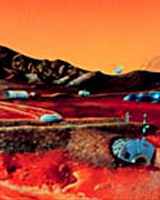 |
Turning finally to the third question
which asked for ideas to help the future community on Mars survive
in an enjoyable and enduring manner, there were many interesting suggestions
here. Several were very human and society oriented, while others were
relatively technical. Some of the specific technical suggestions occurred
at lower frequency, probably because many of the respondents were
unaware of such technical matters as "terraforming", coping
with the harsh survival conditions on Mars, constructing a solar system
Internet, adapting future robots to help humans in crucial ways, and
even the distant possibility of genetically redesigning the human
body to better adapt to the Martian conditions.
Perhaps surprisingly, only two respondents alluded to the issue of community governance, and there were no references to utopian or communal societies. In any event, it is hoped that the MMP participants will fold in the best of these ideas along with their own to arrive at interesting and promising designs for a small human community on Mars in the year 2030. There was a total of 148 suggestions from the 72 contributors in the various categories given below. Please note, however, that the many diverse types of suggestions given for the future Martian community could have been grouped into different structures than the one shown below, which leads to the following most frequently occurring reasons: 1. 18% – The importance of meeting spiritual and cultural hunger needs through staying in touch with ourselves and in blending the arts and sciences for the most enjoyable environment. Many respondents declared that it was not sufficient for the body to survive if the soul should starve. Specific suggestions included clarifying or redefining meaning in life, having easy access to Earth's stories and images, and striving for uplifting architecture and great views. No longer will a collection of drab engineering "habs" suffice, dropped in the middle of a vast and dusty plain. 2. 10% – The importance of maintaining a diverse mix of people, including ethnic types, ages, sexes and, perhaps most important, skills to deal with both raw survival issues and providing the needed food for the soul. With only 100 humans in this MMP scenario, however, choices must be made with care. 3. 10% – The need for extensive communication networks on Mars and between Mars and Earth. Though largely recommended by engineers and scientists, many recognized the essential value in staying connected to information and to other humans. Our own burgeoning information age is clear testimony to this point. 4. 9% – The importance of exploring and learning everything possible about Mars, overlooking nothing it has to offer. Though mostly the suggestion of scientists, a few artists also wanted Mars to be carefully observed from the new landscapes and sunsets down to the most close–up details. Exploring a new frontier has always been popular. 5. 7% – The enormous importance, from the very first planning stages, of designing the community with great care. The art and skill of "systems design" is not commonly appreciated (except by a few to whom it is practically a religion), but it is critical that all facets of starting anew on another world such as Mars be managed using a systems approach. Attention to detail, such as designing efficient habitats, will always be critical to success. 6. 7% – The importance of creating an Earth–like environment by any means possible, including terraforming, holodecks to create virtual experiences, archives of books and films, and even popular public events. As Mars is clearly no match for Earth's great biosphere or its infinite variety of human activities, many respondents felt that steps had to be taken to compensate for these shortcomings. 7. 6% – The great value in using robotic devices in the most effective way to both prepare for the arrival of the first humans and to support the community during and after it has been established. In any harsh environment, robots have been indispensable, but there are many other tasks that they can accomplish better than humans. By relieving humans of as many tasks as possible, humans will have more time to cope with making the new community a success. 8. 6% – Adopting principles that will allow the community "society" to operate effectively. These include important goals such as having a clear purpose, developing a sense of ownership, simplifying wherever feasible, finding a form of governance that works, learning how to start anew on another world, and recognizing that society is the "ultimate machine". 9. 6% – Ensuring the availability of adequate water, food, and other needed resources. This seems too obvious to need explanation, yet relatively few respondents made a special point of it. Clearly, technology must be adapted to handle these needs. Some even stressed the importance of learning to "live off the land", in order to reduce the need for supply ships from Earth. An early determination of suitable Martian raw materials will be essential. 10. 4% – Allowing Mars and its new citizens to find their own voice and their own uniqueness, rather than trying to make the conditions like those on Earth. This courageous view was taken by a few and bears thought. If the proposed Martian community is ever to be the envy of people still on Earth, it may well need its own signature. 11. 17% – What's left is a variety of different suggestions, no one of which exceeds about 3% of the total. Included are running the community like a business, developing affordable transportation, eliminating most of the stifling laws and regulations that evolved on Earth, developing courage and commitment, providing an escape route for humankind if Earth becomes at risk, enjoying low gravity (particularly when older), developing new games, protecting the Martian environment, locating habitats below ground, assessing new risks to humans, genetically redesigning the human body, and learning to adapt. In regard to the above list, there were many notable differences. Relative to #1, more artists than technical respondents, by 1.5 to 1, suggested the need to feed the soul. Relative to #2, more scientists recommended, by 2 to 1, the vital importance of having the necessary skill mix within the community. Relative to #3, engineers and scientists cited the need for communication networks by 5 to 1 over the same suggestion by artists. For #4 about exploring, the same ratio occurred. For#6, half again as many scientists as artists expressed a wish for an Earth–like environment. For #7, again the engineers and scientists cited, by 6 to 1 over the artists, the need for robots to assist the human community. For #9, the technical respondents again listed the importance of obtaining the necessary resources by 5 to 1 over the artists. Finally, for #10, only the artists and no engineers or scientists argued for the importance of allowing Mars and its new inhabitants to find their own unique voices. |
|||
 |
 |
